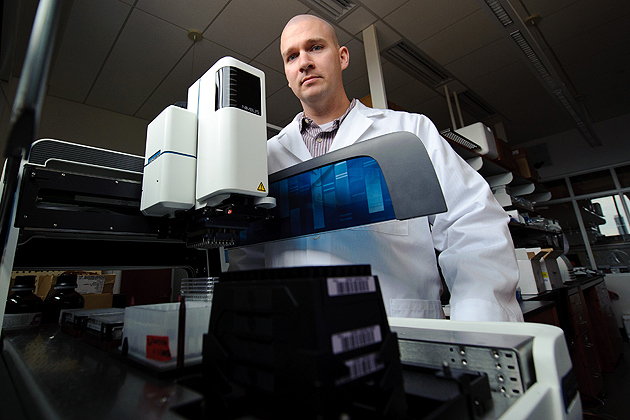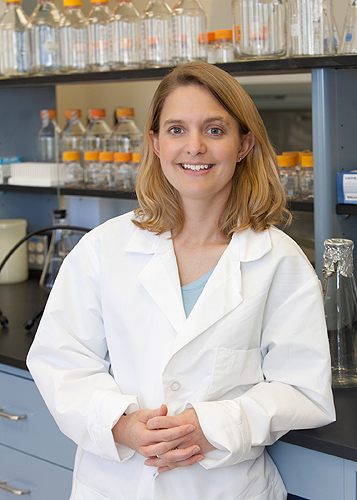
Six teams of UConn researchers are entering the new academic year with $100,000 grants under a program that provides seed money for promising interdisciplinary, inter-campus research proposals.
The 2012 winners of UCIG Awards – the University of Connecticut Health Center/Storrs and Regional Campus Incentive Grants – are conducting research that could yield important insights into diagnosing and treating conditions that affect millions of people worldwide.
They include some forms of cancer, tooth decay, back pain caused by degenerating discs, and a genetic disorder that causes morbid obesity and developmental problems among children.
The six UConn research teams are each sharing $100,000 over the next two years through the UCIG program, which has distributed nearly $2 million since it was launched in 2008. The program is intended to help UConn scholars get their research projects on firm footing, putting them in a strong position to compete for external funding through federal programs and other grant sources.

“The common attribute the funded proposals share is that they are all exceedingly innovative,” says Suman Singha, UConn’s senior vice provost and vice president for research. “This is seed money that is getting people from the campuses working together, collaborating together, coming up with innovative ideas, and then taking them to the next level.”
The competition started in 2008 with single-year grants of $50,000 each to 11 teams. UConn changed the procedure in 2009 to create two-year grants for six winning teams, recognizing that intensive lab work and other parts of the research often need more than one year to blossom.
As in previous years, this funding cycle’s winning teams come from diverse academic backgrounds, with at least one member of each team based at Storrs and at least one at the UConn Health Center. But they all have in common the desire to push scientific boundaries with potentially transformative work to benefit UConn’s research mission and society as a whole.
This year’s awards competition drew 44 short proposals from interested research teams. Eleven were invited to write and submit detailed proposals, and the finalists were selected this spring.
The research disciplines of the six UCIG winning teams’ members range from cell biology and medicine to biomaterials, pharmaceutical sciences, chemistry, and pediatric dentistry.
“In terms of jump-starting research work and fostering communication between campuses, it’s been a very successful program,” says Linda Pescatello, a professor in the Department of Kinesiology in the Neag School of Education who teamed with others under UCIG grants in 2008 and 2009 and was on this year’s selection committee.
This is seed money that is getting people from the campuses working together, collaborating together, coming up with innovative ideas, and then taking them to the next level.
With 12 schools and colleges and more than 85 research centers and institutes, UConn invests more than $200 million annually in research. Like the UCIG program, many of the research awards promote new interactions between experts from diverse disciplines to maximize UConn’s array of scholarship, discovery, and potential for innovation.
UConn has been able to preserve the UCIG program’s budget in recent belt-tightening years through careful planning, and by placing it among the top priorities based on its potential for long-term scientific and academic returns. “You need to invest in what is important to the institution, and this is exceedingly important and has shown that the payoff is evident,” Singha says.
Pescatello concurs, saying the University grants help the recipients continue to pursue critical research interests despite challenging external economic factors.
“In today’s funding environment, receiving these internal grants allows you to address your research questions, and to collect data that will make you more competitive for extramural applications,” she says. “These allow work to continue that otherwise might not have been able to.”
The 2012 recipients and their research projects are:
- Non-Invasive Near-Infrared Imaging of Tumor-Targeting Patient-Derived Antibiotics: Kevin Claffey, Cell Biology; Quing Zhu, Electrical and Computer Engineering.
- High-Throughput Screen to Identify Potential Therapeutics for Prader-Willi Syndrome: Kyle Hadden, Pharmaceutical Sciences; Stormy Chamberlain, Genetics and Developmental Biology.
- Dentin Regeneration with Functional End-Capped Polylactic Acid (PLA) Scaffolds: Rajeswari Kasi, Chemistry; Mina Mina, Pediatric Dentistry; Jon Goldberg, Reconstructive Sciences; Liisa Kuhn, Reconstructive Sciences.
- Overcoming Nano-Molecular Interactions to Achieve Anti-Cancer Efficacy from Nanoparticle Delivery Systems: Diane Burgess, Pharmaceutical Sciences; Liisa Kuhn, Reconstructive Sciences; Bryan Huey, Chemical Materials and Biomolecular Engineering.
- Monitoring the Effects of Cancer-Association Mutations on Conformational Dynamics of DNA Mismatch Repair Proteins: Christopher Heinen, Medicine; Nathan Alder, Molecular & Cell Biology.
- Controlled Growth Factor Release for Tissue Regeneration Using a Novel Affinity Hydrogel: Isaac Moss, Orthopedic Surgery; Yong Wang, Chemical, Materials and Biomolecular Engineering.



